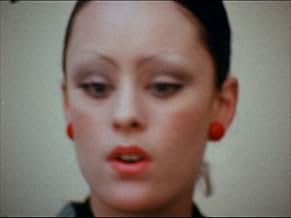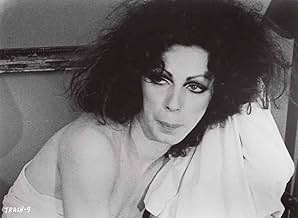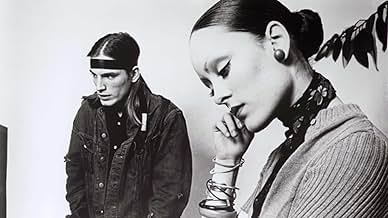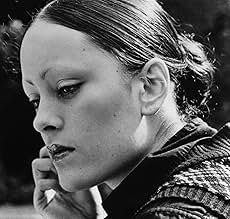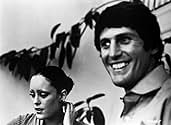IMDb रेटिंग
6.1/10
3 हज़ार
आपकी रेटिंग
अपनी भाषा में प्लॉट जोड़ेंDuring the course of a day, a heroin addict overdoses in front of an upper-class couple, attempts to fool welfare by having his girlfriend fake a pregnancy, and frustrates the women in his l... सभी पढ़ेंDuring the course of a day, a heroin addict overdoses in front of an upper-class couple, attempts to fool welfare by having his girlfriend fake a pregnancy, and frustrates the women in his life with his drug-induced impotence.During the course of a day, a heroin addict overdoses in front of an upper-class couple, attempts to fool welfare by having his girlfriend fake a pregnancy, and frustrates the women in his life with his drug-induced impotence.
- पुरस्कार
- कुल 1 जीत
फ़ीचर्ड समीक्षाएं
Trash does everything a good underground movie should: it portrays a squalid milieu unabashedly; it deconstructs cinema technique to the point of obliterating it; it provides the kind of transgressive kicks that can normally only be had in places frequented by men in raincoats. It's a sick movie but it's far from repulsive. Spatially it's a disaster, and performance-wise it's even worse, but the rawness of it, the (nearly) complete lack of pretense, is refreshing given the false nobility of so many films that seek to criticize the same dregs, the same lower-rung wash-outs, that this movie unflinchingly presents. The film offers undistilled squalor, unfiltered dubious behavior, but does so with its tongue planted firmly in its cheek.
The "plot" is a loosely connected series of episodes involving the strangely magnetic Joe Dallesandro's encounters with various women, all of whom want to get in his pants. What Joe wants is not sex but drugs; he's an unapologetic junkie whose life entails drifting from one partner to another, holing up here and there, doing whatever women want as long as he thinks they'll give him money. And what an array of women: first there's the young go-go dancer (Geri Miller) who does a charming nude frolic to a rock and roll tune; then there's Holly (the drag queen Holly Woodlawn), Joe's main source of housing and income, a buck-toothed broad (?) who furnishes her apartment with garbage she picks up off the side of the road (her coffee table is a lobster-trap). And of course we mustn't forget the woman identified only as Rich Girl (Andrea Feldman), a Grosse Pointe, Michigan deb, transplanted to New York, whose house Joe breaks into, much to her delight. The most memorable sequence involves Rich Girl, who becomes giddy at the prospect of the muscular, well-endowed Joe raping her (she invites him to do it on the couch), then helps Joe bathe while her husband (Rich Guy?) waits in the living room. The performance of Andrea Feldman can only be described as gratingly off-key, but Feldman, with her plucked eyebrows and fabulous bone-structure, is fun to watch anyway, doing the most outrageous, unfair caricature of upper-crust vacuity imaginable. The sequence reaches a kind of crazy comic height when Joe starts shooting heroin with Rich Girl and her hubby watching, Rich Girl rattling on and on about how she's never seen anyone shoot drugs before, and has never done drugs herself, and was a virgin when she married her husband, the heaviness of Dallesandro's muscular, veiny body providing a kind of counterpoint to the vapid, nasally flow of words. Much of the movie hinges on the contrast between Dallesandro's druggy torpor, his eyes barely able to focus, and the nervous energy thrown off by the various women. The parade of horrendous, high-pitched female acting streams past while Dallesandro remains immovable, a lean, sexually-indifferent force of nature.
It's amazing to watch Dallesandro, a man devoid of anything you might call talent but blessed with more raw magnetism than most Hollywood stars. You can't say that he has personality, exactly, but he does have an overpowering physical presence, and a strangely likable quality that he conveys almost in spite of himself. He spends almost the entire movie listening to women babble, enduring their clumsy seductions, and what makes it all so funny is how oblivious he is, how unconcerned with anything but figuring out how to score more smack. Joe (the character) is a man of total integrity - he makes no particular effort to ingratiate himself, and doesn't pretend to be anything other than what he is. Director Paul Morrissey has an enormous affection for Joe, who he sees as a silent movie character, a smack-head Little Tramp (the film opens and closes with a tune straight out of a silent movie). Had the film been made in the twenties, Joe would've been the dogged hero suffering the abuses of society while never losing his dignity or his hat; in the '60s, Joe is not dignified so much as impenetrably dense, and whatever drives him forward is not doggedness but a kind of blind instinct for survival. Society's abuses are not delineated much (except in the clankingly phony last scene, where Joe and Holly try to swindle a crooked Welfare rep, and the tone becomes almost self-righteous), but there's always this suggestion of forces at work against Joe and his companions, the looming specter of injustice.
The film is consistent in its anti-film aesthetic, its transgressive attitude, its sub-hard-core sense of shock. It's not an avant-garde film in the same knowing, self-absorbed way as one of Kenneth Anger's fetishistic, devilish orgies. It has an innocence to it, the innocence of two kids playing doctor in the bushes. It's not the kind of movie that wants to beat you over the head with hipness; it's a surprisingly accessible film, at times a lovable one. Of course it helps not to be too uptight when viewing it: a catalogue of the film's more explicit content includes oral-sex (shot from behind the man, the woman's hands all over his pimply butt); some rather blunt, not-particularly-erotic "regular" sex; numerous images of Dallesandro's impressive member; penetration-by-beer-bottle; and, of course, lots of needles going into veins (and one pubescent backside). In another film this might all seem repugnant, even irresponsible, but in Trash this material represents the mere facts of life. And who but the most easily offended could get riled about the facts of life?
The "plot" is a loosely connected series of episodes involving the strangely magnetic Joe Dallesandro's encounters with various women, all of whom want to get in his pants. What Joe wants is not sex but drugs; he's an unapologetic junkie whose life entails drifting from one partner to another, holing up here and there, doing whatever women want as long as he thinks they'll give him money. And what an array of women: first there's the young go-go dancer (Geri Miller) who does a charming nude frolic to a rock and roll tune; then there's Holly (the drag queen Holly Woodlawn), Joe's main source of housing and income, a buck-toothed broad (?) who furnishes her apartment with garbage she picks up off the side of the road (her coffee table is a lobster-trap). And of course we mustn't forget the woman identified only as Rich Girl (Andrea Feldman), a Grosse Pointe, Michigan deb, transplanted to New York, whose house Joe breaks into, much to her delight. The most memorable sequence involves Rich Girl, who becomes giddy at the prospect of the muscular, well-endowed Joe raping her (she invites him to do it on the couch), then helps Joe bathe while her husband (Rich Guy?) waits in the living room. The performance of Andrea Feldman can only be described as gratingly off-key, but Feldman, with her plucked eyebrows and fabulous bone-structure, is fun to watch anyway, doing the most outrageous, unfair caricature of upper-crust vacuity imaginable. The sequence reaches a kind of crazy comic height when Joe starts shooting heroin with Rich Girl and her hubby watching, Rich Girl rattling on and on about how she's never seen anyone shoot drugs before, and has never done drugs herself, and was a virgin when she married her husband, the heaviness of Dallesandro's muscular, veiny body providing a kind of counterpoint to the vapid, nasally flow of words. Much of the movie hinges on the contrast between Dallesandro's druggy torpor, his eyes barely able to focus, and the nervous energy thrown off by the various women. The parade of horrendous, high-pitched female acting streams past while Dallesandro remains immovable, a lean, sexually-indifferent force of nature.
It's amazing to watch Dallesandro, a man devoid of anything you might call talent but blessed with more raw magnetism than most Hollywood stars. You can't say that he has personality, exactly, but he does have an overpowering physical presence, and a strangely likable quality that he conveys almost in spite of himself. He spends almost the entire movie listening to women babble, enduring their clumsy seductions, and what makes it all so funny is how oblivious he is, how unconcerned with anything but figuring out how to score more smack. Joe (the character) is a man of total integrity - he makes no particular effort to ingratiate himself, and doesn't pretend to be anything other than what he is. Director Paul Morrissey has an enormous affection for Joe, who he sees as a silent movie character, a smack-head Little Tramp (the film opens and closes with a tune straight out of a silent movie). Had the film been made in the twenties, Joe would've been the dogged hero suffering the abuses of society while never losing his dignity or his hat; in the '60s, Joe is not dignified so much as impenetrably dense, and whatever drives him forward is not doggedness but a kind of blind instinct for survival. Society's abuses are not delineated much (except in the clankingly phony last scene, where Joe and Holly try to swindle a crooked Welfare rep, and the tone becomes almost self-righteous), but there's always this suggestion of forces at work against Joe and his companions, the looming specter of injustice.
The film is consistent in its anti-film aesthetic, its transgressive attitude, its sub-hard-core sense of shock. It's not an avant-garde film in the same knowing, self-absorbed way as one of Kenneth Anger's fetishistic, devilish orgies. It has an innocence to it, the innocence of two kids playing doctor in the bushes. It's not the kind of movie that wants to beat you over the head with hipness; it's a surprisingly accessible film, at times a lovable one. Of course it helps not to be too uptight when viewing it: a catalogue of the film's more explicit content includes oral-sex (shot from behind the man, the woman's hands all over his pimply butt); some rather blunt, not-particularly-erotic "regular" sex; numerous images of Dallesandro's impressive member; penetration-by-beer-bottle; and, of course, lots of needles going into veins (and one pubescent backside). In another film this might all seem repugnant, even irresponsible, but in Trash this material represents the mere facts of life. And who but the most easily offended could get riled about the facts of life?
After viewing Trash a second time I have to say that if Joe Dallesandro had not been in this film I doubt people would want to sit through it more than once. Maybe, but most likely not.
The film isn't bad but the acting is amateurish just enough to be distracting. The film is gritty, grimy and has a.... well, a trashy feel to it. Even Joe's fingernails in close-ups are dirty. But he is beautiful to behold. Young men today would give anything to have that body and let's be honest here, the camera loves his nude physique and we see a lot of it here. Full frontal male nudity.
It's hard not to become involved in the film because these people are desperate. They are barely able to survive. Somehow they manage to hold their heads up high and demand respect from other people even though they are living at the bottom of the barrel and very much need the welfare payments they are seeking.
The delivery of the dialog is out of place at times and it's hard to figure out how the actors went from point A to point B. Still, it is interesting to watch and Joe definitely looks good on screen.
The film isn't bad but the acting is amateurish just enough to be distracting. The film is gritty, grimy and has a.... well, a trashy feel to it. Even Joe's fingernails in close-ups are dirty. But he is beautiful to behold. Young men today would give anything to have that body and let's be honest here, the camera loves his nude physique and we see a lot of it here. Full frontal male nudity.
It's hard not to become involved in the film because these people are desperate. They are barely able to survive. Somehow they manage to hold their heads up high and demand respect from other people even though they are living at the bottom of the barrel and very much need the welfare payments they are seeking.
The delivery of the dialog is out of place at times and it's hard to figure out how the actors went from point A to point B. Still, it is interesting to watch and Joe definitely looks good on screen.
It's a shame some people consider this and it's companion pieces to be Andy Warhol films when they really have very little relation at all to the Warhol style and Warhol himself had nothing to do with them. The credit goes to Morrisey and his superstar weirdos. What's even more shocking is that these films are considered to be such works of intellectual art when this movie at least is unashamed pure comedy and not much else. A very funny comedy at times granted, but not a great intelectual work, though it has some social relevance of course. The final scene with the social worker is one of the best comedy scenes in movies, or would be if it weren't for the amateurness of the actor playing the social worker. On the minus, you do have to wonder about the ethics of Morrisey since this film is also, to a small degree, a freak show.
10Casey-52
I became familiar with the Paul Morrissey-Joe Dallesandro trilogy by watching "Flesh". I loved it, but there were many flaws that could not be overlooked (i.e., forgettable acting, bad editing and sound, boring intervals in plot). I did expect better with "Trash" and it delivered more than I wished for.
Joe Dallesandro gives another fantastic performance as a junkie who will do anything for heroin. But unlike his appearance in "Flesh", Joe barely creates any sexual longing from the audience. The plotline is simple: Joe wants heroin, his girlfriend Holly wants welfare, and you get to see some strange characters and situations as they try to reach their goal(s). Morrissey produced several winning actors in "Flesh", one of which was Geri Miller as a ditzy but lovable stripper. Geri plays another ditzy but lovable stripper and is just as good, if not better, here. For those of you who remember hearing her conversation about choosing between plant juice or silicone for her breast implants, you can't help but wonder which she picked, for in a stripping sequence, Geri's breasts are noticeably larger. It is in this film that I noticed Morrissey's casting is similar to that of John Waters: Morrissey-Geri Miller; Waters-Cookie Mueller Morrissey-Jane Forth; Waters-Mary Vivian Pearce Morrissey-Andrea Feldman; Waters-Edith Massey (in the "where the hell did they come from?" category)
Candy Darling and Jackie Curtis are gone from the cast, but to take both of their places is Holly Woodlawn, who steals the film from absolutely everybody! She was supposed to have been nominated for an Oscar for her performance in this film, but because Holly is a transvestite, there was questioning as to which category? She is fabulous, better than any other Warhol star before or since, and is both hilarious and heartbreaking. Andrea Feldman is a wild, outrageous character actress and while her voice is annoying, her personality is interesting. Jane Forth, a 16-year-old actress, has an equally annoying voice, but her performance as a talkative rich snob is great. Other notable appearances include Johnny Putnam, who was Holly Woodlawn's 16-year-old boyfriend, as a teen looking for dope and Michael Sklar as the welfare officer. Diane Podlewski as Holly's pregnant sister and Bruce Pecheur as Jane's husband aren't as memorable.
"Trash" features better editing style, better sound quality, better improvised dialogue, better stylistic camerawork, great sets, and a MUCH better ensemble cast. I would recommend this film more than any other Morrissey film besides perhaps "Blood for Dracula". Highly recommended!
Joe Dallesandro gives another fantastic performance as a junkie who will do anything for heroin. But unlike his appearance in "Flesh", Joe barely creates any sexual longing from the audience. The plotline is simple: Joe wants heroin, his girlfriend Holly wants welfare, and you get to see some strange characters and situations as they try to reach their goal(s). Morrissey produced several winning actors in "Flesh", one of which was Geri Miller as a ditzy but lovable stripper. Geri plays another ditzy but lovable stripper and is just as good, if not better, here. For those of you who remember hearing her conversation about choosing between plant juice or silicone for her breast implants, you can't help but wonder which she picked, for in a stripping sequence, Geri's breasts are noticeably larger. It is in this film that I noticed Morrissey's casting is similar to that of John Waters: Morrissey-Geri Miller; Waters-Cookie Mueller Morrissey-Jane Forth; Waters-Mary Vivian Pearce Morrissey-Andrea Feldman; Waters-Edith Massey (in the "where the hell did they come from?" category)
Candy Darling and Jackie Curtis are gone from the cast, but to take both of their places is Holly Woodlawn, who steals the film from absolutely everybody! She was supposed to have been nominated for an Oscar for her performance in this film, but because Holly is a transvestite, there was questioning as to which category? She is fabulous, better than any other Warhol star before or since, and is both hilarious and heartbreaking. Andrea Feldman is a wild, outrageous character actress and while her voice is annoying, her personality is interesting. Jane Forth, a 16-year-old actress, has an equally annoying voice, but her performance as a talkative rich snob is great. Other notable appearances include Johnny Putnam, who was Holly Woodlawn's 16-year-old boyfriend, as a teen looking for dope and Michael Sklar as the welfare officer. Diane Podlewski as Holly's pregnant sister and Bruce Pecheur as Jane's husband aren't as memorable.
"Trash" features better editing style, better sound quality, better improvised dialogue, better stylistic camerawork, great sets, and a MUCH better ensemble cast. I would recommend this film more than any other Morrissey film besides perhaps "Blood for Dracula". Highly recommended!
After Flesh, this is the second of the Flesh-Trash-Heat trilogy of the Joe Dallessandro-Andy Warhol-Paul Morrissey collaboration. This is much more pacier than Flesh, and it has more solid conversation although obviously the actors have again been left on their own to improvise. The context is much more specifically set than Flesh again (thanks to better editing I guess), and the mood is darker and gloomier.
The transvestite Holly Woodlawn is truly grand as the lost and desperate girlfriend who is helplessly in love with the impotent drug addict Joe.
Trash is also more critical about the state of the American nation in the 60's.
The transvestite Holly Woodlawn is truly grand as the lost and desperate girlfriend who is helplessly in love with the impotent drug addict Joe.
Trash is also more critical about the state of the American nation in the 60's.
क्या आपको पता है
- ट्रिवियाIn the winter of 1970, Holly Woodlawn received a telegram from the Academy of Motion Picture Arts and Sciences informing her that the legendary, Oscar-winning director George Cukor had started a campaign to get the Academy to nominate her for an Academy Award for "Trash," supported by petitions whose signatories included Ben Gazzara and Oscar-winner Joanne Woodward. Ultimately, Holly was not nominated.
- इसके अलावा अन्य वर्जनUnlike his predecessor John Trevelyan the new UK censor Stephen Murphy had little time for Warhol's movies and, again unlike Flesh (1968), Trash would receive a checkered history in the UK. The film was rejected for a UK cinema certificate in 1971 and only passed the following year in a much shorter form (the distributor having removed around 8 mins of dialogue) and with heavy BBFC cuts which removed heroin scenes, a sequence where Holly attempts to fellate Joe, and an infamous masturbation scene involving Holly and a beer bottle. The initial 1991 UK video release by Virgin Video featured the same heavily cut cinema version, which was then cut by a further 1 minute 12 secs by the BBFC to remove shots of instructive heroin use. The 1996 First Independent Films video release featured the original longer print which restored the dialogue edits and the fellatio/masturbation scenes, though 2 mins 20 secs of BBFC cuts were again made to the heroin scenes. The film was finally passed completely uncut in the UK in June 2005.
- कनेक्शनEdited into Porn to Be Free (2016)
- साउंडट्रैकMama Look at Me Now
Sung by Geri Miller
टॉप पसंद
रेटिंग देने के लिए साइन-इन करें और वैयक्तिकृत सुझावों के लिए वॉचलिस्ट करें
- How long is Trash?Alexa द्वारा संचालित
विवरण
बॉक्स ऑफ़िस
- बजट
- $25,000(अनुमानित)
इस पेज में योगदान दें
किसी बदलाव का सुझाव दें या अनुपलब्ध कॉन्टेंट जोड़ें


